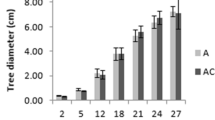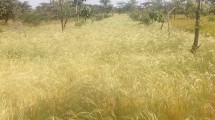Abstract
A scarcity of cultivation land calls for more intensive and productive land use in the East Usambara Mountains in NE Tanzania. Spice crops could generate cash in higher parts of the mountains, but the present cultivation methods are depleting the valuable forest resources. The trial was established at the end of 2000 to find out how the two popular cash crops, cardamom (Elettaria cardamomum (L.) Maton.) and black pepper (Piper nigrum L.), normally grown under the natural forest, will produce in intensive agroforestry system with two multipurpose farm trees, Grevillea robusta A.Cunn. and nitrogen fixing Gliricidia sepium Jacq. Results from 6 years showed that cardamom produced better with grevillea than in natural forest; 5.5 times more in the fourth year than the average in the area. The Land Equivalent Ratios for black pepper and cardamom showed that pepper intercropped with grevillea produced 3.9 times more than in monoculture whereas cardamom intercropped with grevillea and pepper produced 2.3 times more than in monoculture. Gliricidia improved the nitrogen and organic matter content of the soil over the levels found in natural forest. Soil acidity was, however, preventing the plants from using the available mineral nutrients more effectively.


Similar content being viewed by others
References
Agroforestree database (2006) World Agroforestry Centre (ICRAF), Nairobi, Kenya. http://www.worldagroforestrycentre.org/sites/TreeDBS/aft.asp. Accessed 21 Oct 2006
Akyeampong E, Hitimana L, Torquebiau E, Munyemana PC (1999) Multistarata agroforestry with beans, bananas, and Grevillea robusta in the highlands of Burundi. Exp Agric 35:357–369. doi:10.1017/S0014479799003063
Amara DS, Kamara AY (1998) Growth and yield of Gliricidia sepium (Jack.) Walp. Provenanaces on an acid sandy clay loam soil in Sierra Leone. Int Tree Crops J 9:169–178
Black pepper cultivation (2007) Spices Board of India, Ministry of commerce, Government of India http://www.indianspices.com/html/ind_sp_farm_02.html. Accessed 30 May 2007
CEPF (Critical Ecosystem Partnership Fund) (2005) Ecosystem profile: Eastern Arc mountains and coastal forests of Tanzania & Kenya. Conservation International and International Centre of Insect Physiology and Ecology, USA, p 118
De Mendiburu F (2007) Agricolae: statistical procedures for agricultural research, R package version 1.0–3. http://tarwi.lamolina.edu.pe/~fmendiburu
Gunathilake HAJ, Wasanthe HG (2004) Gliricidia—for production of green manure and green energy in coconut plantations. In: Zoysa AKN, Ziyad Mohamed MT (eds) Proceeding of the first symposium on plantation crop research “Current trends and future challenges”, The Tea Research Institute of Sri Lanka, pp 43–52
Hamilton AC, Bensted-Smith R (eds) (1989) Forest conservation in the east Usambara mountains. IUCN, Gland, Switzerland and Cambridge, Tanzania, p 392
Harwood CE (1989) Grevillea robusta: an annotated bibliography. ICRAF, p 123
Huang W, Luukkanen O, Johansson S, Kaarakka V, Räisänen S, Vihemäki H (2002) Agroforestry for biodiversity conservation of nature reserves: functional group identification and analysis. Agrofor Syst 55:65–72. doi:10.1023/A:1020284225155
Jolliffe PA (1997) Are mixed populations of plant species more productive than pure stands? Nordic ecological society. Oikos 80(3):595–602. doi:10.2307/3546635
Korikanthimanth VS (2001) Cardamom (small). In: Peter KV (ed) Handbook of herbs and spices, Woodhead 1:123–133
Korikanthimanth VS, Mulge R, Hedge R, Hiremath GG, Hosmani MM (1998) Crop Combination and yield pattern in coffee mix cropped with cardamom. J Plantation Crops 26(1):41–49
Kumar BM, Kumar VS, Mathew T (1995) Floristic attributes of small cardamom (Elettaria cardamomum (L.) Maton) growing areas in the Western Ghats of peninsular India. Agrofor Syst 31:275–289. doi:10.1007/BF00712079
Masayanyika SWS (1995) Linking conservation with livelihood security. The case of east Usambara mountains, Amani Division, Tanga region, Tanzania. M.Sc. thesis. Department of Land Resources and Urban Sciences, International Institute for Aerospace Survey and Earth Sciences, Enschede, p 109
Mead R, Willey RW (1980) The concept of a ‘land equivalent ratio’ and advantages in yields from intercropping. Exp Agric 16:217–228
Muchiri M (2001) Yield and management of maize—Grevillea robusta agroforestry system in Kenya. D.Sc. thesis summary, Research notes of the faculty of forestry no: 132, University of Joensuu
Nair KPP, Sadanandan AK, Hamza S, Abraham J (1997) The importance of potassium buffer power in the growth and yield of cardamom. J Plant Nutr 20(7&8):987–997
Newmark WD (2000) Conserving biodiversity in east African forests. A study of the eastern Arc mountains. Ecological studies 155. Springer-Verlag, Berlin Heidelberg, p 197
NRI-note (Natural Resources Institute) (2005) Biomass-energy toolbox. Growth and development of short-rotation coppice crops, Gliricidia sepium. p 12 http://www.nri.org/projects/biomass/conference_papers/gliricidia_sepium_species_notes.pdf. Accessed 21 Nov 2006
Patil BP (1989) Cut down fertilizer nitrogen need of rice by Gliricidia green manure. Indian Farming 29:34–35
Purseglove JW, Brown EG, Green CL, Robbins SRJ (1981) Spices. Longman Group Limited, New York, p 719
Rao MR, Palada MC, Becker BN (2004) Medicinal and aromatic plants in agroforestry systems. Agrofor Syst 61:107–122. doi:10.1023/B:AGFO.0000028993.83007.4b
Reyes T, Luukkanen O, Quiroz R (2006) Small cardamom—precious for people, harmful for mountain forests: possibilities for sustainable cultivation in the east Usambaras, Tanzania. Mt Res Dev 26(2):131–137. doi:10.1659/0276-4741(2006)26[131:SCFPHF]2.0.CO;2
Sah S (1996) Use of farmers’ knowledge to forecast areas of cardamon cultivation. An application of a participatory land suitability analysis in east Usambaras. ITC, Tanzania, p 161
Sitaubi LA (1990) Foliar nitrogen levels of some dry zone hardwood species in Malawi. In: Prinsley RT (ed) Agroforestry for sustainable production. Economic Implications. Commonwealth Science Council, London, pp 305–310
Sivaraman K, Kandiannan K, Peter KV, Thankamani CK (1999) Agronomy of black pepper (Piper nigrum L.)—a review. J Spices Aromatic Crops 8(1):1–18
Stocking M, Perkin S (1992) Conservation-with-development: and application of the concept in the Usambara Mountains, Tanzania. Trans Inst Br Geogr N Ser 17:337–349. doi:10.2307/622884
Tejwani KG (1994) Agroforestry in India. Oxford & IBH Publishing Co. Ptv. Ltd, New Delhi, p 233
Thankamani CK, Kandiannan K, Mathew PA, Srinivasan V (2007) Propagate black pepper through serpentine method. Spice India 20:17–20
Vandermeer JH (1989) The ecology of intercropping. Cambridge University Press, Cambridge, p 256
Yasu H (1999) The diffusion process of planting Grevillea robusta among rural households in North-Central Tanzania. Afr Study Monogr 20(3):119–145
Yin X, Goudriaan J, Lantinga EA, Vos J, Spiertz HJ (2003) A flexible sigmoid function of determinate growth. Ann Bot (Lond) 91:361–371. doi:10.1093/aob/mcg029
Author information
Authors and Affiliations
Corresponding author
Rights and permissions
About this article
Cite this article
Reyes, T., Quiroz, R., Luukkanen, O. et al. Spice crops agroforestry systems in the East Usambara Mountains, Tanzania: growth analysis. Agroforest Syst 76, 513–523 (2009). https://doi.org/10.1007/s10457-009-9210-5
Received:
Accepted:
Published:
Issue Date:
DOI: https://doi.org/10.1007/s10457-009-9210-5




